Input interpretation

NH_3 ammonia ⟶ H_2 hydrogen + NH_2NH_2 diazane
Balanced equation

Balance the chemical equation algebraically: NH_3 ⟶ H_2 + NH_2NH_2 Add stoichiometric coefficients, c_i, to the reactants and products: c_1 NH_3 ⟶ c_2 H_2 + c_3 NH_2NH_2 Set the number of atoms in the reactants equal to the number of atoms in the products for H and N: H: | 3 c_1 = 2 c_2 + 4 c_3 N: | c_1 = 2 c_3 Since the coefficients are relative quantities and underdetermined, choose a coefficient to set arbitrarily. To keep the coefficients small, the arbitrary value is ordinarily one. For instance, set c_2 = 1 and solve the system of equations for the remaining coefficients: c_1 = 2 c_2 = 1 c_3 = 1 Substitute the coefficients into the chemical reaction to obtain the balanced equation: Answer: | | 2 NH_3 ⟶ H_2 + NH_2NH_2
Structures

⟶ +
Names

ammonia ⟶ hydrogen + diazane
Reaction thermodynamics
Enthalpy
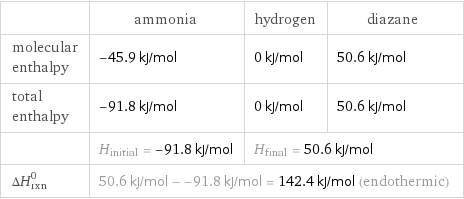
| ammonia | hydrogen | diazane molecular enthalpy | -45.9 kJ/mol | 0 kJ/mol | 50.6 kJ/mol total enthalpy | -91.8 kJ/mol | 0 kJ/mol | 50.6 kJ/mol | H_initial = -91.8 kJ/mol | H_final = 50.6 kJ/mol | ΔH_rxn^0 | 50.6 kJ/mol - -91.8 kJ/mol = 142.4 kJ/mol (endothermic) | |
Gibbs free energy
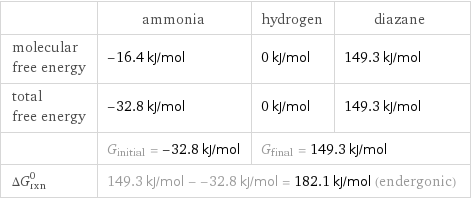
| ammonia | hydrogen | diazane molecular free energy | -16.4 kJ/mol | 0 kJ/mol | 149.3 kJ/mol total free energy | -32.8 kJ/mol | 0 kJ/mol | 149.3 kJ/mol | G_initial = -32.8 kJ/mol | G_final = 149.3 kJ/mol | ΔG_rxn^0 | 149.3 kJ/mol - -32.8 kJ/mol = 182.1 kJ/mol (endergonic) | |
Entropy
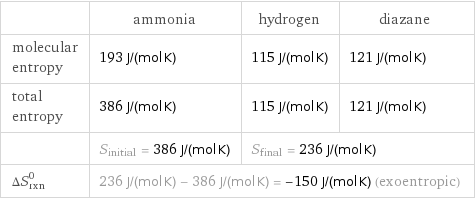
| ammonia | hydrogen | diazane molecular entropy | 193 J/(mol K) | 115 J/(mol K) | 121 J/(mol K) total entropy | 386 J/(mol K) | 115 J/(mol K) | 121 J/(mol K) | S_initial = 386 J/(mol K) | S_final = 236 J/(mol K) | ΔS_rxn^0 | 236 J/(mol K) - 386 J/(mol K) = -150 J/(mol K) (exoentropic) | |
Equilibrium constant
![Construct the equilibrium constant, K, expression for: NH_3 ⟶ H_2 + NH_2NH_2 Plan: • Balance the chemical equation. • Determine the stoichiometric numbers. • Assemble the activity expression for each chemical species. • Use the activity expressions to build the equilibrium constant expression. Write the balanced chemical equation: 2 NH_3 ⟶ H_2 + NH_2NH_2 Assign stoichiometric numbers, ν_i, using the stoichiometric coefficients, c_i, from the balanced chemical equation in the following manner: ν_i = -c_i for reactants and ν_i = c_i for products: chemical species | c_i | ν_i NH_3 | 2 | -2 H_2 | 1 | 1 NH_2NH_2 | 1 | 1 Assemble the activity expressions accounting for the state of matter and ν_i: chemical species | c_i | ν_i | activity expression NH_3 | 2 | -2 | ([NH3])^(-2) H_2 | 1 | 1 | [H2] NH_2NH_2 | 1 | 1 | [NH2NH2] The equilibrium constant symbol in the concentration basis is: K_c Mulitply the activity expressions to arrive at the K_c expression: Answer: | | K_c = ([NH3])^(-2) [H2] [NH2NH2] = ([H2] [NH2NH2])/([NH3])^2](../image_source/0e58ef95a5ff3b1d37301f73884c05d2.png)
Construct the equilibrium constant, K, expression for: NH_3 ⟶ H_2 + NH_2NH_2 Plan: • Balance the chemical equation. • Determine the stoichiometric numbers. • Assemble the activity expression for each chemical species. • Use the activity expressions to build the equilibrium constant expression. Write the balanced chemical equation: 2 NH_3 ⟶ H_2 + NH_2NH_2 Assign stoichiometric numbers, ν_i, using the stoichiometric coefficients, c_i, from the balanced chemical equation in the following manner: ν_i = -c_i for reactants and ν_i = c_i for products: chemical species | c_i | ν_i NH_3 | 2 | -2 H_2 | 1 | 1 NH_2NH_2 | 1 | 1 Assemble the activity expressions accounting for the state of matter and ν_i: chemical species | c_i | ν_i | activity expression NH_3 | 2 | -2 | ([NH3])^(-2) H_2 | 1 | 1 | [H2] NH_2NH_2 | 1 | 1 | [NH2NH2] The equilibrium constant symbol in the concentration basis is: K_c Mulitply the activity expressions to arrive at the K_c expression: Answer: | | K_c = ([NH3])^(-2) [H2] [NH2NH2] = ([H2] [NH2NH2])/([NH3])^2
Rate of reaction
![Construct the rate of reaction expression for: NH_3 ⟶ H_2 + NH_2NH_2 Plan: • Balance the chemical equation. • Determine the stoichiometric numbers. • Assemble the rate term for each chemical species. • Write the rate of reaction expression. Write the balanced chemical equation: 2 NH_3 ⟶ H_2 + NH_2NH_2 Assign stoichiometric numbers, ν_i, using the stoichiometric coefficients, c_i, from the balanced chemical equation in the following manner: ν_i = -c_i for reactants and ν_i = c_i for products: chemical species | c_i | ν_i NH_3 | 2 | -2 H_2 | 1 | 1 NH_2NH_2 | 1 | 1 The rate term for each chemical species, B_i, is 1/ν_i(Δ[B_i])/(Δt) where [B_i] is the amount concentration and t is time: chemical species | c_i | ν_i | rate term NH_3 | 2 | -2 | -1/2 (Δ[NH3])/(Δt) H_2 | 1 | 1 | (Δ[H2])/(Δt) NH_2NH_2 | 1 | 1 | (Δ[NH2NH2])/(Δt) (for infinitesimal rate of change, replace Δ with d) Set the rate terms equal to each other to arrive at the rate expression: Answer: | | rate = -1/2 (Δ[NH3])/(Δt) = (Δ[H2])/(Δt) = (Δ[NH2NH2])/(Δt) (assuming constant volume and no accumulation of intermediates or side products)](../image_source/01f8780c91a3b8456c759e91427762bf.png)
Construct the rate of reaction expression for: NH_3 ⟶ H_2 + NH_2NH_2 Plan: • Balance the chemical equation. • Determine the stoichiometric numbers. • Assemble the rate term for each chemical species. • Write the rate of reaction expression. Write the balanced chemical equation: 2 NH_3 ⟶ H_2 + NH_2NH_2 Assign stoichiometric numbers, ν_i, using the stoichiometric coefficients, c_i, from the balanced chemical equation in the following manner: ν_i = -c_i for reactants and ν_i = c_i for products: chemical species | c_i | ν_i NH_3 | 2 | -2 H_2 | 1 | 1 NH_2NH_2 | 1 | 1 The rate term for each chemical species, B_i, is 1/ν_i(Δ[B_i])/(Δt) where [B_i] is the amount concentration and t is time: chemical species | c_i | ν_i | rate term NH_3 | 2 | -2 | -1/2 (Δ[NH3])/(Δt) H_2 | 1 | 1 | (Δ[H2])/(Δt) NH_2NH_2 | 1 | 1 | (Δ[NH2NH2])/(Δt) (for infinitesimal rate of change, replace Δ with d) Set the rate terms equal to each other to arrive at the rate expression: Answer: | | rate = -1/2 (Δ[NH3])/(Δt) = (Δ[H2])/(Δt) = (Δ[NH2NH2])/(Δt) (assuming constant volume and no accumulation of intermediates or side products)
Chemical names and formulas
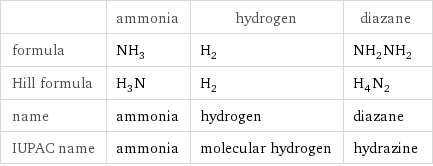
| ammonia | hydrogen | diazane formula | NH_3 | H_2 | NH_2NH_2 Hill formula | H_3N | H_2 | H_4N_2 name | ammonia | hydrogen | diazane IUPAC name | ammonia | molecular hydrogen | hydrazine
Substance properties
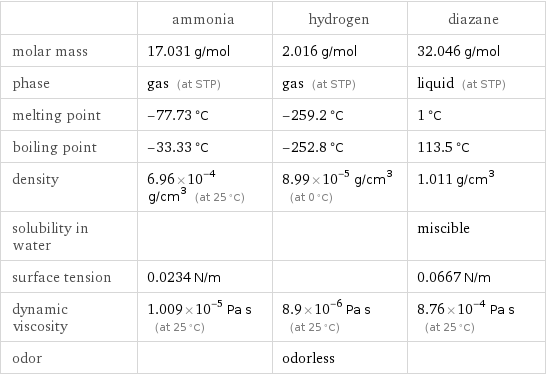
| ammonia | hydrogen | diazane molar mass | 17.031 g/mol | 2.016 g/mol | 32.046 g/mol phase | gas (at STP) | gas (at STP) | liquid (at STP) melting point | -77.73 °C | -259.2 °C | 1 °C boiling point | -33.33 °C | -252.8 °C | 113.5 °C density | 6.96×10^-4 g/cm^3 (at 25 °C) | 8.99×10^-5 g/cm^3 (at 0 °C) | 1.011 g/cm^3 solubility in water | | | miscible surface tension | 0.0234 N/m | | 0.0667 N/m dynamic viscosity | 1.009×10^-5 Pa s (at 25 °C) | 8.9×10^-6 Pa s (at 25 °C) | 8.76×10^-4 Pa s (at 25 °C) odor | | odorless |
Units
